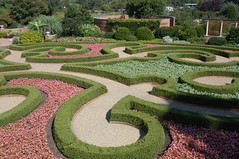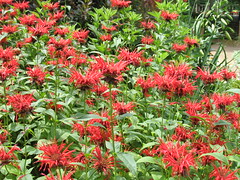
The Ruth Palmer Blanke Boxwood Garden is designed to display the Missouri Botanical Garden’s outstanding collection of boxwood, which is notoriously difficult to grow in the Midwest. There are 60 unique varieties of Boxwood in the Boxwood Garden. Boxwood has been valued in gardens for thousands of years, from the “pleasure gardens” of ancient Persia and the landscapes of Greece and Rome, to the formal gardens of Europe. There are no native North American boxwoods; the first plantings in this country were made by colonial settlers who imported cuttings from England, France and Holland. Boxwood then moved westward with the pioneers. The elegant beauty of boxwood gives shape, structure and evergreen foliage to any garden setting.

In the spring of 2009, a new entrance was completed. Visitors enter the Ruth Palmer Blanke Boxwood Garden through a handsome open brick courtyard that allows them to see inside the garden. This new opening features a fountain with vertical sprays of water that run continuously. Two entry paths are flanked by perennial borders and boxwoods and wind around brick walls. Visitors discover a formal oval boxwood parterre accented with colorful flowers and ground cover.
Surrounding the plantings at the center of the garden are boxwood borders informally planted to show off the annual display and to provide a framework for the garden. In contrast to the garden’s formality are fountains with random leapfrog jets that jump into the air and arch over the paths, interspersed with round pools with continuously playing vertical jets of water.

As visitors follow the paths, they arrive at a pavilion resting on a rise and find a quiet place to sit in the shade. Here they may enjoy the view of the beautifully designed boxwood garden and the surrounding grounds of the English Woodland Garden.
The Missouri Botanical Garden’s interest in boxwood stems from the work of the late Edgar Anderson, former director of the Garden and a distinguished member of its scientific staff for 40 years. In 1969, Dr. Anderson established a test program at the Garden to identify hardy strains of boxwood collected from Asia and the Balkans. The Edgar Anderson Boxwood Memorial Area, accessible by the steps on the east side of the Garden, showcases the Boxwood that Anderson obtained during his 1934 trip to the Balkans. There are 18 unique kinds of Boxwood in the Edgar Anderson Area.